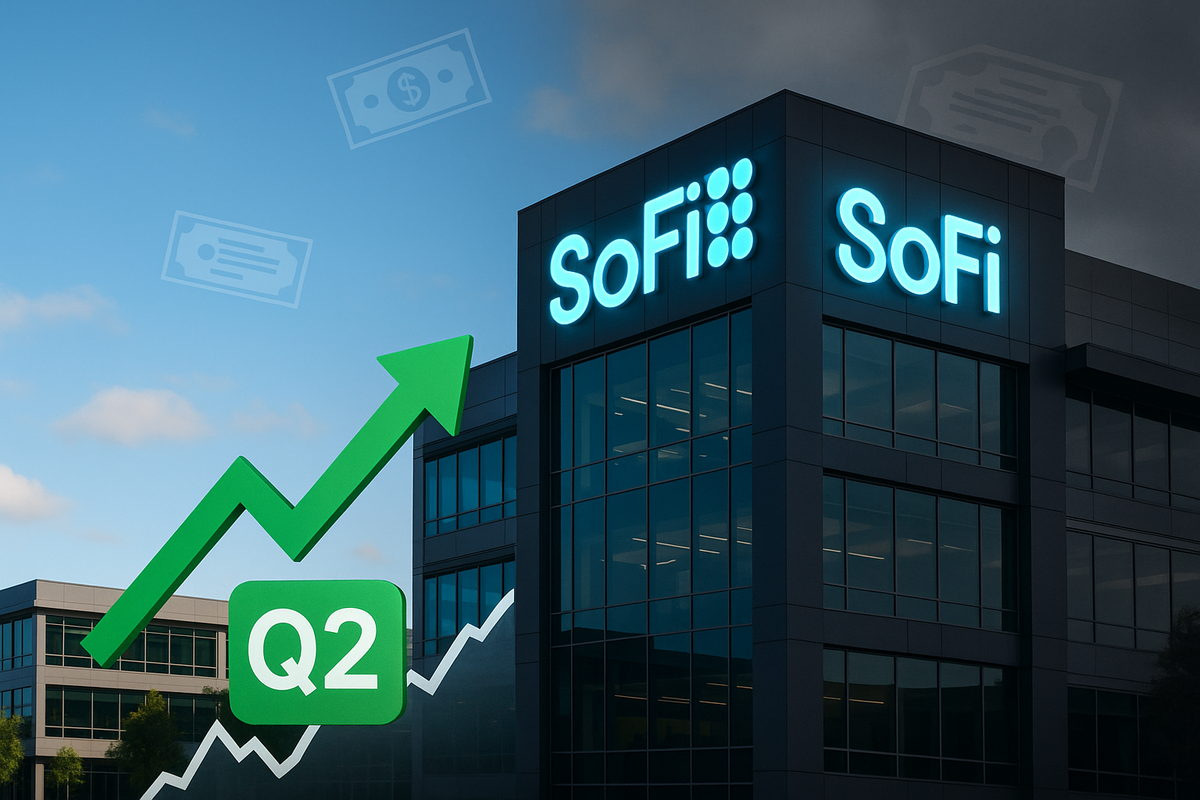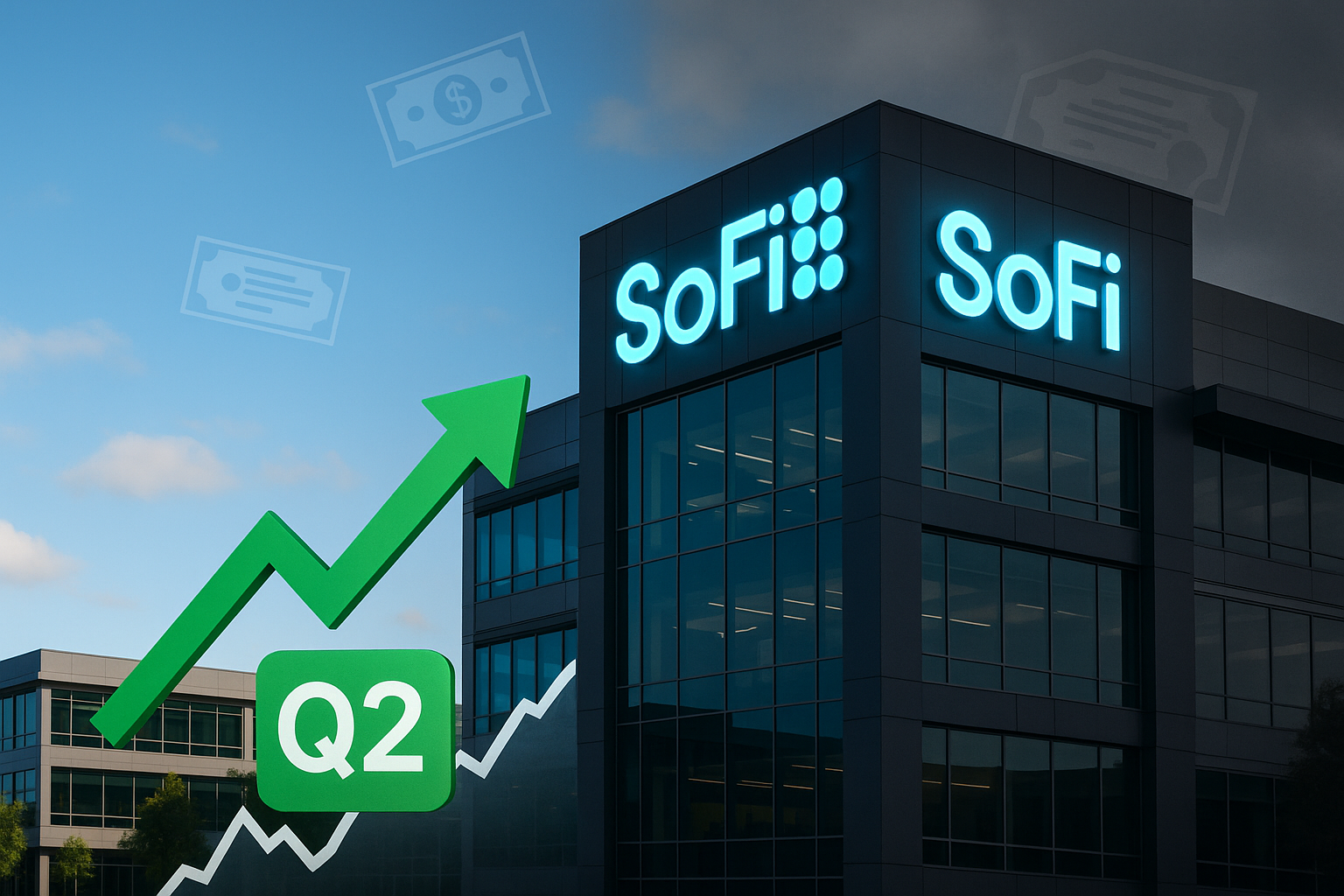SoFi Surges on Stellar Q2 Results, But Stock Offering Casts Shadow (NASDAQ: SOFI)


SoFi Technologies (NASDAQ: SOFI) delivered a robust performance in its second quarter of 2025, reporting record revenues, continued profitability, and impressive user growth. The fintech giant's strong earnings initially sent its stock soaring, signaling investor confidence in its diversified financial services model. However, the enthusiasm was tempered by the announcement of a significant public offering of common stock, raising concerns about potential share dilution and leading to a subsequent pullback in after-hours trading.
SoFi's Stellar Q2 Performance and Its Market Impact
SoFi's Q2 2025 earnings report showcased a company firing on all cylinders. The firm reported a record GAAP net revenue of $854.9 million, a substantial 43% year-over-year increase, and an adjusted net revenue of $858 million, surpassing analyst expectations of $804.23 million. This growth was significantly bolstered by a 72% year-over-year surge in fee-based revenue, which now accounts for 44% of adjusted net revenue, highlighting a successful pivot towards a more diversified and less interest-rate-sensitive income stream.
For the seventh consecutive quarter, SoFi achieved GAAP profitability, with a net income of $97.3 million and diluted earnings per share (EPS) of $0.08, exceeding the forecasted $0.06. Adjusted EBITDA also saw an impressive 81% increase to $249.1 million, demonstrating strong operational efficiency. The company's member base expanded by a record 850,000 new members, reaching a total of 11.7 million, while product additions also hit a record 1.26 million, totaling 17.1 million products. This consistent user and product growth underscores the effectiveness of SoFi's "financial services productivity loop," where cross-selling to existing members drives further engagement and revenue. Total loan originations hit $8.8 billion, a 64% increase, with personal loan originations up 66% year-over-year. The Financial Services segment's net revenue more than doubled from the prior year to $362.5 million, and total deposits grew to $29.5 billion.
The immediate market reaction was overwhelmingly positive, with SoFi's stock initially jumping over 16% in pre-market trading and nearly 18% at market open. This surge reflected investor optimism regarding the company's accelerating growth trajectory and improved profitability. However, the subsequent announcement of a $1.5 billion public offering of common stock introduced a note of caution. While intended to strengthen the company's balance sheet and support future growth initiatives, the prospect of share dilution led to a 6.6% decline in after-hours trading, nearly erasing the day's earlier gains. This mixed market reaction highlights the delicate balance between growth funding and shareholder value. SoFi also raised its full-year 2025 guidance, expecting adjusted net revenue of approximately $3.375 billion and adjusted EBITDA of around $960 million, projecting to add at least 3 million new members in 2025.
Winners and Losers in the Wake of SoFi's Earnings
SoFi's robust Q2 performance positions it as a significant player in the evolving financial landscape, creating potential winners and losers across the industry. The most immediate winner is undoubtedly SoFi Technologies (NASDAQ: SOFI) itself, as its strong financial results and continued expansion validate its diversified business model. The company's ability to grow its member base, increase product adoption, and achieve consistent profitability, even amidst a challenging economic environment, signals a strong competitive advantage. Shareholders who held the stock prior to the earnings release benefited from the initial surge, despite the subsequent dilution concerns.
On the other hand, traditional banks and legacy financial institutions might find themselves on the losing end as fintechs like SoFi continue to capture market share. Companies such as JPMorgan Chase (NYSE: JPM), Bank of America (NYSE: BAC), and Wells Fargo (NYSE: WFC) face increasing pressure to innovate and adapt to the digital-first preferences of consumers. SoFi's success in attracting deposits and cross-selling a wide array of financial products, from lending to investing and banking, directly competes with the core offerings of these established players. While traditional banks possess vast resources and established customer bases, their slower pace of digital transformation could lead to a gradual erosion of their competitive edge, particularly among younger demographics.
Within the fintech sector, SoFi's strong performance could create a mixed bag. For smaller, niche fintechs, SoFi's success might serve as a benchmark and a testament to the viability of digital-first financial services. However, it also intensifies competition. Companies like LendingClub (NYSE: LC) or Upstart (NASDAQ: UPST), which primarily focus on lending, might face increased pressure from SoFi's expanding loan origination volumes and diversified revenue streams. SoFi's ability to leverage its banking charter for lower cost of funds and its integrated platform for higher customer lifetime value gives it a distinct advantage over fintechs that rely solely on partnerships or a single product offering. The public offering, while dilutive in the short term, provides SoFi with substantial capital to further invest in technology, marketing, and potential acquisitions, potentially widening the gap between it and less capitalized competitors.
Industry Impact and Broader Implications
SoFi's Q2 results are not just a win for the company; they represent a significant milestone in the broader financial services industry's ongoing transformation. This event underscores the accelerating shift towards integrated digital financial platforms, where consumers can manage multiple aspects of their financial lives within a single ecosystem. SoFi's "financial services productivity loop," which encourages cross-buying of products, is becoming a blueprint for how fintechs can achieve sustainable growth and profitability beyond just lending. This trend challenges the traditional siloed approach of banking, where different products are often managed by separate divisions or even separate institutions.
The ripple effects of SoFi's success are likely to be felt across the competitive landscape. Competitors, both traditional and digital, will be compelled to enhance their own digital offerings and explore similar integrated models. Traditional banks may accelerate their investments in digital transformation, potentially through acquisitions of smaller fintechs or by developing their own super-apps. For instance, companies like Capital One (NYSE: COF) or Discover Financial Services (NYSE: DFS), which have strong digital presences, might intensify their efforts to expand beyond their core credit card or lending businesses into broader financial services. Partners in the fintech ecosystem, such as technology providers and data analytics firms, could see increased demand for their services as financial institutions seek to build out more robust digital platforms.
From a regulatory perspective, SoFi's continued profitability as a chartered bank could draw further attention to the regulatory framework for fintechs. Its success might encourage more fintechs to pursue banking charters, seeking the benefits of lower funding costs and direct access to payment systems. This could lead to increased scrutiny from regulators like the OCC and FDIC, who will need to balance fostering innovation with ensuring financial stability and consumer protection. Historically, the financial industry has seen cycles of disruption, from the rise of credit unions to the emergence of online brokers. SoFi's current trajectory echoes the early days of companies like Charles Schwab (NYSE: SCHW) or Fidelity, which revolutionized investing by offering more accessible and integrated services, eventually forcing traditional brokerages to adapt or fade. SoFi's model, combining lending, banking, and investing, represents a similar paradigm shift for the broader financial services sector.
What Comes Next for SoFi and the Market
Looking ahead, SoFi's Q2 performance and strategic moves set the stage for several key developments in both the short and long term. In the short term, the market will closely watch the execution of the $1.5 billion public offering of common stock. While it caused initial jitters due to dilution concerns, successful deployment of this capital into growth initiatives, such as expanding product offerings, enhancing technology, or strategic acquisitions, could quickly alleviate investor fears and drive further appreciation. SoFi's ability to maintain its impressive user and product growth rates in the coming quarters will be crucial for sustaining investor confidence. The company's raised full-year guidance suggests continued optimism, and meeting or exceeding these targets will be a significant catalyst.
In the long term, SoFi is poised to further solidify its position as a leading digital financial services provider. The company's strategic pivot towards fee-based revenue and its integrated platform model will likely continue to drive profitability and reduce reliance on interest rate fluctuations. Potential strategic pivots could include deeper dives into specific niches within financial services, such as wealth management for high-net-worth individuals, or expanding its B2B services through Galileo and Technisys. Market opportunities may emerge from continued consolidation in the fintech space, allowing SoFi to acquire smaller players with complementary technologies or customer bases. Challenges could arise from increased regulatory oversight, intense competition from both traditional banks and other well-funded fintechs, and potential economic downturns that could impact loan performance.
Potential scenarios include SoFi becoming a dominant "super-app" in the U.S. financial landscape, akin to WeChat in China, offering a comprehensive suite of services that makes it indispensable to its users. Another scenario could see increased partnerships with traditional financial institutions, where SoFi's technology powers their digital transformation efforts. Conversely, a more challenging scenario might involve a significant economic downturn impacting loan quality or a regulatory crackdown that stifles innovation. However, given its current trajectory and strategic capital raise, SoFi appears well-positioned to navigate these possibilities and continue its growth trajectory, aiming to add at least 3 million new members in 2025.
Conclusion: SoFi's Trajectory and Investor Outlook
SoFi's Q2 2025 earnings report marks a pivotal moment for the company, underscoring its successful transition to a diversified, profitable, and rapidly growing financial services enterprise. The key takeaways are clear: robust revenue growth driven by a strategic shift to fee-based services, consistent GAAP profitability, and impressive expansion of its member and product base. These achievements validate SoFi's integrated financial services model and its ability to effectively cross-sell to its growing customer base. While the subsequent stock offering introduced short-term volatility, it also provides the necessary capital for sustained long-term growth and strategic expansion.
Moving forward, the market will be closely assessing SoFi's ability to maintain its growth momentum, effectively deploy its newly raised capital, and continue to innovate in a highly competitive environment. The company's raised full-year guidance reflects strong internal confidence, and investors will be watching for consistent execution against these targets. SoFi's success also highlights a broader trend in the financial industry: the increasing dominance of digital-first, integrated platforms that offer a seamless customer experience across multiple financial products.
For investors, SoFi represents a compelling growth story within the fintech sector. Its unique position as a chartered bank with a strong technology backbone provides a competitive edge. Key indicators to watch in the coming months include continued growth in member and product additions, the performance of its loan portfolio amidst varying economic conditions, the expansion of its fee-based revenue streams, and any further strategic partnerships or acquisitions. SoFi's journey from a student loan refi company to a comprehensive financial services provider is a testament to its adaptability and strategic vision, positioning it as a significant force shaping the future of finance.



